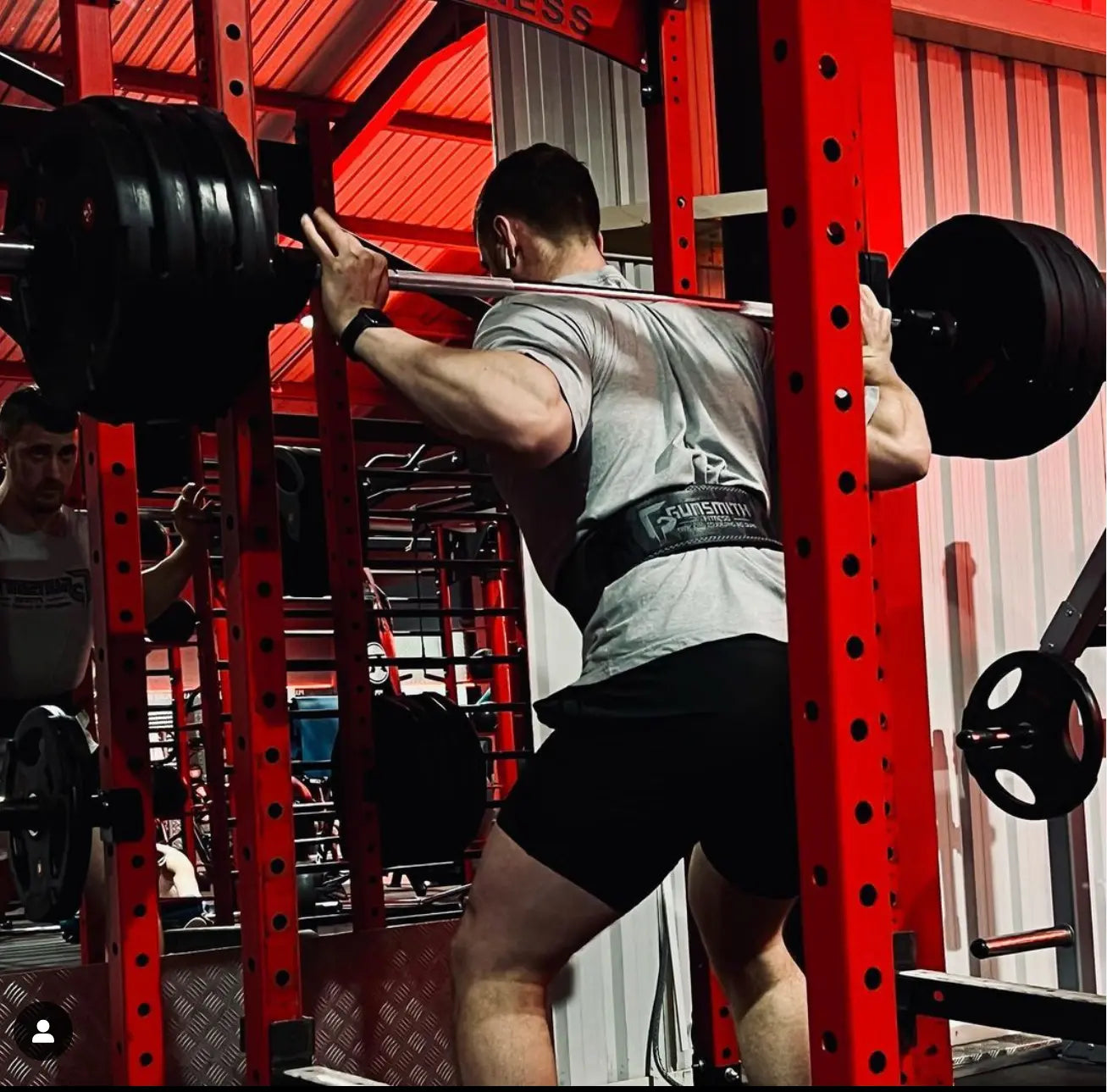
How Can I Improve My Squat Strength?
The meatheads here at Gunsmith Fitness love to keep things simple, and not just because we’re all a bit slow in the head. Our general philosophy has always been Keep It Simple, Stupid, or K.I.S.S. for short.
For that reason, and many others, we love our big compound lifts. Bench presses, deadlifts, overhead presses, and even the occasional olympic lift like the clean and jerk. While these all rank high on our list of most beloved exercises, the one that really holds a special place in our hearts is the squat.

You’ve probably heard before, especially if you frequent this blog, that the squat is the King of Lifts, or King of Exercises. This isn’t just something we’ve made up, it’s fairly conventional wisdom in weightlifting, bodybuilding and powerlifting circles.
You see, many people think the squat is only a leg exercise, and that’s simply not true. The squat could more accurately be seen as a full-body exercises, with a focus on the lower body.
Because of all this, we absolutely love squats. Many lifters hate them, and part of the reason is because they’re not good at them. If you could learn some simple, effective ways to improve your squat strength, you would probably enjoy squatting more.
Benefits of Squats
Before we get into the meat of this article, which is actually improving your squat strength, we should go over some of the general benefits you can expect to see from squatting regularly. If you knew all of the ways in which squatting could improve your life, you’d probably be a lot more motivated to add them to your routine.
Bigger, Stronger Legs

This is probably the most obvious one, being that the squat tends to focus on the leg muscles. The squat works the glutes, quads, hamstrings and calves, which pretty much covers all of the muscles in your legs.
Are you tired of having skinny little chicken legs showing when you wear shorts in the summer? There’s no better way of bulking your legs up than adding in some squats once or twice a week.
Increased Core Strength
When we talk about the core, we’re not just talking about abs. This is a common mistake, and can actually lead to muscular imbalances if lifters only focus on working their abdominals, while neglecting the rest of their core, which also includes the obliques and back muscles.
When you stack a barbell on your back and then move it up and down, you’re engaging all of your core muscles as well, which leads to a stronger core and ultimately a stronger, healthier body which is less prone to injury.
Increased Vertical Jump
For bodybuilders and powerlifters, this isn’t such a big deal. But for athletes and fitness-minded people in general, having a high vertical jump is important and often a point of pride.
Increased Mobility

Having increased mobility doesn’t just mean you’re flexible. It also is a measurement of how effective you are along that range of motion. Practicing the deep squat motion with weight, where you at least break parallel with your knees, is great for training your muscles, joints and ligaments to have power throughout the full range of motion of your knees, hips and back.
Burn More Fat (Like, a lot)
It’s fairly common knowledge that the more muscle a person has, the more calories they’ll burn throughout the day. Because the squat builds and strengthens a group of the largest muscles in your body, not only will you burn more calories while squatting, but that fat-burning effect will carry over to your day-to-day activities as your muscles grow.
Injury Prevention
Now we won’t flat-out say that lifting weights, or squatting in particular, can prevent injuries, but they can definitely help make you less likely to be injured during daily activities. Think about it: most injuries are caused by people doing something their body isn’t used to doing.
Because the squat improves fully body strength, hip stability, knee strength and mobility, you’re way less likely to experience an injury doing other activities. More than likely, your squat routine is the toughest thing you’ll experience all week.
Improved Posture
This is a big benefit for anyone that works primarily at a desk with a computer or laptop. Our bodies weren’t made to be sitting hunched over in front of a computer monitor all day, and that takes a big toll on our back and neck. You’ll often see this in people that slouch or have forward-rolling shoulders.
Squatting can help correct these imbalances, because it forces you to have perfect posture. Once you have been squatting for a few months, and your muscles have grown, it will feel much more natural to you to maintain good posture.
Boost Your Hormones
While this may sound like Bro-Science, it’s actually 100% legit: squatting helps promote natural hormone production, such as testosterone and growth hormone. Just run a quick Google search, and you’ll find countless articles linking squats with greater hormone levels.
How To Improve Squats
With some of the main benefits of squatting out of the way, we hope to have convinced you to add the squat into your workout routine, at least once or twice per month. Now we can move on to how to actually improve your squat so you’re making the most out of your workout.
Squat Twice A Week
Yes you heard (read) that right. If you really want to get better at something, it always helps to do it more often. More repetitions and more practice equals proficiency and, eventually, mastery.
While it may seem excessive, there are a lot of exercise programs that recommend squatting twice, and even three times per week! This is more achievable when you’re still squatting a relatively low amount of weight.
If you’ve been hitting the squats for a few years already, this may not help you out. But if you’re still able to make weekly or semi-weekly progress in the amount of weight you squat, then bumping up the frequency could help you out.
Increase The Weight Slowly
Milo of Croton was an Ancient Greek wrestler, who is best known for training by carrying a bull calf from the day it was born, all the way up to maturity. Because the calf only grew by a small amount per day, Milo's body was able to adjust to the increase in weight and become stronger.
We all want to get stronger, and we want it done yesterday, but the secret to healthy, long-lasting progress is to take it slow. With squats, and most big lifts in general, it’s best to increase the weight by about 5 lbs per week. This means using the micro plates, which are 2.5lbs each.
By increasing the weight in smaller increments, over time we can get to the point where we're putting up serious numbers.
Try Front Squats
When trying to increase your weight in a specific lift, the best thing to do is practice that specific lift more often. The second best thing to do is to practice an ancillary lift.
For example, if you were trying to improve your bench press and found that your shoulders and triceps were strong enough, but that your pecs were underdeveloped, you may decide to focus instead on heavy dumbbell flys. This would put all the weight on your chest, instead of relying on supporting muscles.
If you’re trying to improve your back squat, try throwing in a couple of other leg exercises. A good one is the front squat, as it works all of the same muscles as the traditional squat, but stresses the muscles differently.
If you’ve only ever done back squats, adding front squats to your routine will work your core and legs like you wouldn’t believe.
Prioritize Squats
There’s a good principle in life that states that every day, you should prioritize what needs to get done, and then do the important things first. If we apply this principle to the gym and lifting weights, we’ll see that we want to prioritize certain lifts, and then do those first thing when entering the gym.
In this case, if you’re trying to get to the point where you’re squatting big weights, you’ll want to do your squats first, right after your warm-up. This ensures that you’re fresh and have plenty of energy for the important lift.
Build More Hip Strength

In modern cultures, the hips are some of the most neglected muscle groups out there. Because we sit for so long each day, and because so many of us don’t practice active stretching, our hips end up being too tight and underdeveloped. This can cause all kinds of problems, from sore knees to back pain, and can definitely slow your progress in the gym.
Even if you’re squatting regularly, your hips can still be the weak point in your muscle chain, so if you’re finding you’re having a hard time increasing your squat, try focusing on strengthening and stretching your hip muscles.
While you may feel a bit self-conscious, nobody is going to care that you’re using the girly hip-stretcher machine, especially once they see you squatting three plates for reps.
Build Upper Back Strength

Yes, we can hear your objections already. “Why would I focus on my UPPER back if I’m trying to improve my squat?”
Well the answer is, the squat really is a full-body exercise. Let’s say you’re trying to squat 225 lbs, which is more weight than most people will ever lift in their lives. Where is the weight sitting while you’re squatting? It’s on your upper back, and most of those muscles are going to be recruited in stabilizing the weight while you lift.
So even though it may seem counterintuitive, improving your upper back strength through exercises such as rows and pull-ups can help with your squat.
Improve Your Core Stability

Squats are, without a doubt, primarily a lower body exercise, but they are also heavily dependent on other muscle chains. Your core muscles play a huge role in stabilizing your body while squatting, by creating intra abdominal pressure which helps to keep your spine straight.
If your core muscles are lacking, you may find your hips rising before the rest of your body. Not only is this highly inefficient movement, but also potentially dangerous. Bad form is the leading cause of injury while squatting.
While wearing a weightlifting belt can help improve intra abdominal pressure, you should also perform core exercises to strengthen the muscles in your abs, obliques and lower back.
Conclusion and Final Thoughts
Are squats an absolute necessity? Of course not, but neither is lifting weights in general. Squats have an incredible number of benefits and will help to raise your overall level of health and fitness to the next level.
By adding squats into your routine, you can build muscle, have a greater aesthetic look and also be functionally more fit and stronger. Need some support during squats? Check out our belt range





